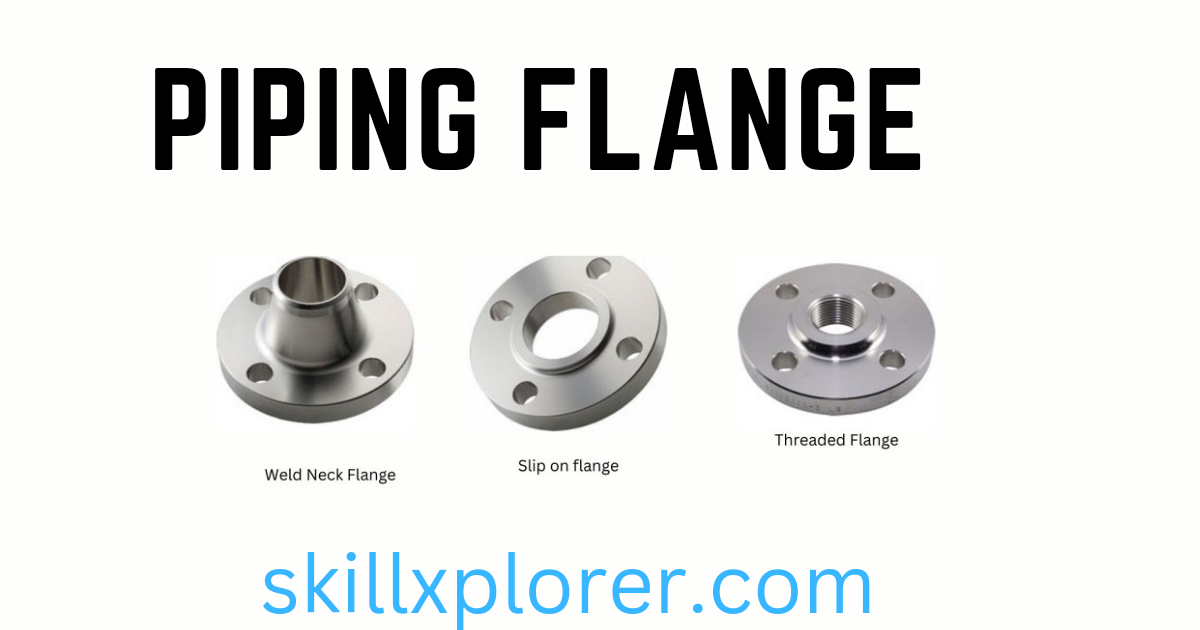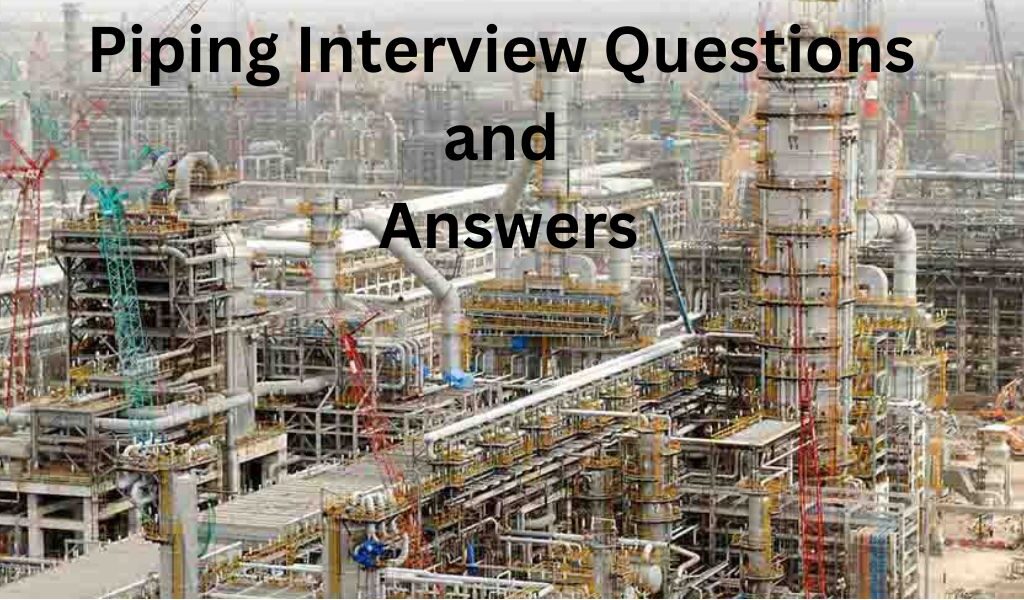Introduction of Piping Interview
Welcome to skillxplorer.com Dear interview aspirant’s If you study these top piping interview questions and answers thoroughly, it will be highly beneficial for your interview. In this article we mentioned top 20 piping interview question.
Piping Interview Questions and Answers
1. What is role of piping supervisor?
The role of a piping supervisor involves coordinating with other systems and services, estimating materials based on drawings, and overseeing the installation, maintenance, and repair of piping systems to ensure they comply with project specifications and safety standards.
2. What is a flange?
A flange is a joint used to connect pipes, valves, or equipment. It is a circular plate with holes for bolts or studs. The number of holes depends on the flange class. Flanges are made of metal and create a secure, leak-proof connection. They are commonly used in piping systems for easy assembly, disassembly, and maintenance.

3. What are the three major categories of piping?
Large Bore: According to pipe fabrication This type of piping has a diameter greater than two inches.
Small bore :- This type of piping has a diameter of 2 inches or smaller.
Tubing: The tubes or pipes used in tubing piping systems come in different sizes and wall thicknesses to accommodate specific requirements. They are often joined together using various methods, such as welding, threading, or compression fittings, to create a continuous flow path. It differs from the normal piping.
4.what is process piping?
Process piping refers to the system of pipes used in industrial facilities to transport fluids and gases during various manufacturing processes.
The ASME B31.3 code is widely used in the design, construction, and maintenance of process piping systems. It provides guidelines and requirements for the design, materials, fabrication, inspection, and testing of piping systems in various industries, including chemical, petrochemical, and oil refineries. Compliance with the ASME B31.3 code ensures the safety and reliability of process piping installations.
5. Where do you use process piping?
The design pressure in piping refers to the maximum pressure that a component within a piping system is designed to withstand safely. It is crucial to ensure that the design pressure of each component is equal to or greater than the highest pressure that could occur during normal operation or any potential upset conditions.
6. what is the major components of piping system?
The major components in a piping system include
pipes, fittings (such as elbows, reducers, and flange connections), flanges
Gaskets, Bolting, Equipment, Valves, and pipe supports.
7. What is weldolet?
Weldolets are a type of branch connection fitting used in piping systems. They are designed to provide a reinforced and reliable connection for branching off from a main pipe to create a smaller branch pipe.
Weldolets are typically welded onto the main pipe through a welding process, hence the name “weldolet.” They feature a main body with an integrally formed branch outlet that allows for the attachment of the branch pipe. This design provides strength and structural integrity to the connection, ensuring a secure and leak-free joint.
8) What are nipples in the piping system?
In piping, a nipple is a short length of pipe with male threads on both ends. It is typically used to connect two female threaded fittings or to extend the length of a fitting.
9) What is SMAW and TIG welding?
SMAW stands for Shielded Metal Arc Welding.
TIG stands for Tungsten Inert Gas Welding.
10. Explain steam tracing?
The purpose of this process is to maintain a high temperature in a process line, ensuring the free flow of fluid and preventing it from freezing, thereby maintaining pumpability.
11) Classification of flanges according to facing?
The types of pipe flange faces include flat face, raised face, tongue and groove, and ring type joint.
12) What is threaded joints?
This method is widely used in various industries as it allows for the joining of many small-sized pipes without material concerns. However, threaded pipe joints are not commonly used in the oil and gas industry, but rather in HVAC piping and other low-pressure piping applications that do not involve hazardous services
13. What is blind flange?
A blind flange is a type of flange used to seal off or close the opening of a piping system or vessel. Unlike other flanges, a blind flange does not have a bore.
14. What is isolation valve?
An isolation valve is a type of valve used to completely shut off the flow of fluid in a piping system. It is primarily designed to isolate or block the flow of fluid in a specific section of a pipeline, allowing for maintenance, repairs, or modifications to be performed on that section without affecting the rest of the system.
15. What is check valve or non return valve?
The check valve operates automatically, relying on the flow of fluid and pressure differential to open or close. When the fluid flows in the desired direction, the check valve opens, allowing the fluid to pass through with minimal resistance. However, if the fluid attempts to flow in the opposite direction, the check valve closes, preventing backflow.
16. What is a regulation valve?
A regulation valve, also known as a control valve, is a type of valve used to regulate or control the flow, pressure, or temperature of a fluid in a piping system. It provides precise control over the fluid parameters to maintain desired process conditions within a system.
16) what is hydrotest ?
Hydrotesting is an essential step in the fabrication, installation, and maintenance of pressure vessels, pipelines, and other pressurized systems. It helps to identify any weaknesses, defects, or potential points of failure in the system, ensuring that it meets the required safety standards and can operate safely under normal operating conditions. The test pressure is always 1.5 design pressure.
17. Classification of flange?
There are several types of Flange
Flat Face (FF)
Rised face
Tongue and groove face
Ring type joint
18. Where should we do a branch connection in a pipeline?
For gas, air, or steam fluids, the branch connection should be made on the top side of the pipe. However, for liquid fluids, the branch connection should be made on the bottom side of the pipe.
19. Explain steam tracing?
To ensure the smooth flow and pumpability of fluid, a process known as freeze protection is implemented in a process line. This involves maintaining a high temperature within the line to prevent the fluid from freezing and causing blockages.
20. Explain pump cavitation?
Cavitation occurs when a pump encounters vapor formation due to the pressure dropping below the vapor pressure of the liquid being pumped. As pumps are designed to handle liquids, not vapor, this can lead to issues.
Thank you


